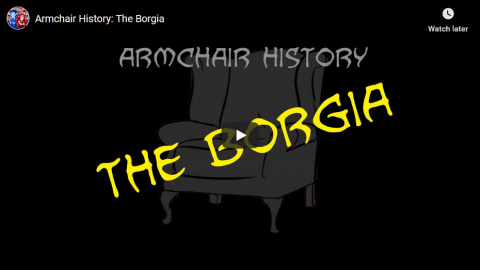World War Two
Published 24 Mar 2020Hans Oster opposed the Nazis and tried to oppose them from early on. As a member of the Abwehr, he tried to do whatever he could. During the war, his efforts increased with a dramatic outcome.
Join us on Patreon: https://www.patreon.com/TimeGhostHistory
Or join The TimeGhost Army directly at: https://timeghost.tvFollow WW2 day by day on Instagram @World_war_two_realtime https://www.instagram.com/world_war_t…
Between 2 Wars: https://www.youtube.com/playlist?list…
Source list: http://bit.ly/WW2sourcesHosted by: Spartacus Olsson
Written by: Isabel Wilson, Joram Appel and Spartacus Olsson
Produced and Directed by: Spartacus Olsson and Astrid Deinhard
Executive Producers: Bodo Rittenauer, Astrid Deinhard, Indy Neidell, Spartacus Olsson
Creative Producer: Joram Appel
Post-Production Director: Wieke Kapteijns
Research by: Arnaldo Teodorani and Isabel Wilson
Edited by: Iryna Dulka
Map animations: Eastory (https://www.youtube.com/c/eastory)Colorizations by:
Dememorabilia – https://www.instagram.com/dememorabilia/Sources:
Picture of Dresden, courtesy Wikimedia Commons https://commons.wikimedia.org/wiki/Fi…
Collection of Auckland War Memorial Museum Tamaki Paenga Hira, N2658
Narodowe Archiwum Cyfrowe
Picture of Gijsbertus Jacobus Sas, courtesy ANP Historisch Archief https://www.anp-archief.nl/page/21998…
Picture of Hans Bernd Gisevius, courtesy Gedenkstätte Deutscher Widerstand https://www.gdw-berlin.de/en/recess/b…
id by Flatart from the Noun Project
people by ProSymbols from the Noun Project
documents by Srinivas Agra from the Noun ProjectSoundtracks from the Epidemic Sound:
Johannes Bornlof – “Deviation in Time”
Andreas Jamsheree – “Guilty Shadows 4”
Fabien Tell – “Last Point of Safe Return”
Reynard Seidel – “Deflection”
Jo Wandrini – “Puzzle of Complexity”
Gunnar Johnsen – “Not Safe Yet”Archive by Screenocean/Reuters https://www.screenocean.com.
A TimeGhost chronological documentary produced by OnLion Entertainment GmbH.
March 25, 2020
Hans Oster – A German Against Nazism – WW2 Biography Special
Armchair History: The Borgia
Overly Sarcastic Productions
Published 30 Jun 2015CONTENT DISCLAIMER: This video no longer meets my standards of quality for historical research and presentation. I made this one in the days long past, when the question of “How do I make an entertaining and historically interesting video” was answered by “IDK, memes I guess?”. This video in particular was an experiment with a shorter format, and is by no means definitive history. Take the video above with a grain of salt and enjoy the jokes.
In what could be a landmark in terms of progress, Overly Sarcastic Productions has decided to start making SHORT videos as well as rather long ones.
The Borgias were one messed up family, I tell you what.
QotD: The broken feedback mechanism that brought down the chain bookstores
… the push-model of book sales. Long before there was an Amazon, chain bookstores had cozy deals with publishers that sent most indie bookstores (now beloved in effigy by the left) out of business.
And then the left dominated publishing establishment had a brilliant idea. For decades they’d been trying to forecast failure and success, and failings. Books they pushed out the wazzoo (A river in Sundon’tshine) died on the vine when bookstores refused to stock them because the owners had read them. The books they had designated as to be ignored caught someone’s fancy, and suddenly were all over.
This was inefficient. It caused way too much printing that never got distributed, and much last minute rushed reprinting. (Even leaving aside how often people chose to read the WRONG things, something that started to matter more and more in the last two decades.)
So they came up with the push model. It was, from a certain perspective, brilliant.
That perspective is the one where the real world doesn’t really exist, so you don’t need to hear from it.
Because the managers of the big corporate bookstores ALSO didn’t read, they took instruction beautifully. So the publishers could say “you’ll take 100 of x and 2 of y” and they DID.
For a little while it worked beautifully, in the sense that there were no surprise bestsellers, (and publishing houses hated those. I know someone who unexpectedly sold out her print run in a week. The publishing house took the book out of print. No, seriously.) and the books that got seen and talked about were picked by the publisher. (BTW this wasn’t even always or primarily political. Sure, that existed too sometimes, but mostly it was the crazy fads that publishing convinced itself of. For instance, sometime in the mid two thousands they convinced themselves no one wanted historical mysteries — they weren’t selling, true, probably because they were on NO shelves — but everyone wanted “chick-lit mysteries” that had covers with lots of shoes and dresses and whose plots were “Sex in the City with murder.” I remember trying to find something to read, giving up and going to the used bookstore (then a hundred miles away in Denver) for my mystery fix.)
Of course, they sold less. In fact, as time went on and people got out of the habit of going to the bookstore, because there was never anything they could find to read. I mean, I remember being chased from Science Fiction to Mystery to finally History, to at last the sort of “utility” book you find in the discount bins you know “a chart of history” type of thing just to find something to buy on our bookstore night.
Then we gave up.
Eventually the broken feedback mechanism gave us the demise of Borders — and B & N is not feeling so good itself — and a yawning, desperate chasm in customers’ need for books that meant the way was wide open for Indie and Amazon. Even the early badly proofed indie books were like a breath of fresh air because for the first time I could read outside the trends being pushed.
Sarah Hoyt, “Breaking the Gears”, According to Hoyt, 2018-01-03.





